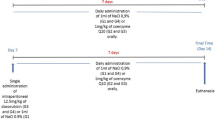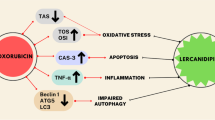Abstract
Doxorubicin (DOX) is used as an anticancer drug despite its several side effects, especially its irreversible impacts on cardiotoxicity. Coenzyme Q10 (Q10) as a powerful antioxidant and lisinopril (LIS) as an angiotensin-converting enzyme inhibitor seem to provide protection against DOX-induced cardiotoxicity. Therefore, this study aimed to assess the cardioprotective effects of Q10 and LIS against DOX-induced cardiotoxicity in rats. Adult male Sprague–Dawley rats were randomly assigned into the control, LIS, Q10, DOX, DOX + LIS, and DOX + Q10 groups. On day 21, ECG was recorded and the right ventricle was dissected for evaluation of catalase activity and malondialdehyde (MDA) concentration. Additionally, the left ventricle and the sinoatrial (SA) node were dissected to assess the stereological parameters. The results of ECG indicated bradycardia and increase in QRS duration and QT interval in the DOX group compared to the control group. Meanwhile, the total volumes of the left ventricle, myocytes, and microvessels and the number of cardiomyocyte nuclei decreased, whereas the total volume of the connective tissue and the mean volume of cardiomyocytes increased in the DOX group. On the other hand, the SA node and the connective tissue were enlarged, while the volume of the SA node nuclei was reduced in the DOX group. Besides, catalase activity was lower and MDA concentration was higher in the DOX‐treated group. Q10 could recover most stereological parameters, catalase activity, and MDA concentration. LIS also prevented some stereological parameters and ECG changes and improved catalase activity and MDA concentration in the DOX group. The findings suggested that Q10 and LIS exerted cardioprotective effects against DOX-induced cardiac toxicity.







Similar content being viewed by others
References
Zhao, N., Woodle, M. C., & Mixson, A. J. (2018). Advances in delivery systems for doxorubicin. Journal of Nanomedicine & Nanotechnology, 9, 10. https://doi.org/10.4172/2157-7439.1000519
Chatterjee, K., Zhang, J., Honbo, N., & Karliner, J. S. (2010). Doxorubicin cardiomyopathy. Cardiology, 115, 155–162.
Mudd, T. W., Jr., Khalid, M., & Guddati, A. K. (2021). Cardiotoxicity of chemotherapy and targeted agents. American Journal of Cancer Research, 11, 1132.
Rochette, L., Guenancia, C., Gudjoncik, A., Hachet, O., Zeller, M., Cottin, Y., & Vergely, C. (2015). Anthracyclines/trastuzumab: New aspects of cardiotoxicity and molecular mechanisms. Trends in Pharmacological Sciences, 36, 326–348.
Takemura, G., & Fujiwara, H. (2007). Doxorubicin-induced cardiomyopathy: From the cardiotoxic mechanisms to management. Progress in Cardiovascular Diseases, 49, 330–352.
Jeyaprakash, P., Sangha, S., Ellenberger, K., Sivapathan, S., Pathan, F., & Negishi, K. (2021). Cardiotoxic effect of modern anthracycline dosing on left ventricular ejection fraction: A systematic review and meta-analysis of placebo arms from randomized controlled trials. Journal of the American Heart Association, 10, 188.
Dolinsky, V. W., Rogan, K. J., Sung, M. M., Zordoky, B. N., Haykowsky, M. J., Young, M. E., Jones, L. W., & Dyck, J. R. (2013). Both aerobic exercise and resveratrol supplementation attenuate doxorubicin-induced cardiac injury in mice. American Journal of Physiology-Endocrinology and Metabolism, 305, E243–E253.
Zhang, S., Liu, X., Bawa-Khalfe, T., Lu, L.-S., Lyu, Y. L., Liu, L. F., & Yeh, E. T. (2012). Identification of the molecular basis of doxorubicin-induced cardiotoxicity. Nature Medicine, 18, 1639–1642.
Botelho, A. F. M., Lempek, M. R., Branco, S. E. M., Nogueira, M. M., de Almeida, M. E., Costa, A. G., Freitas, T. G., Rocha, M. C. R., Moreira, M. V., & Barreto, T. O. (2019). Coenzyme Q10 cardioprotective effects against doxorubicin-induced cardiotoxicity in Wistar rat. Cardiovascular Toxicology, 20, 222.
Chen, P. Y., Hou, C. W., Shibu, M. A., Day, C. H., Pai, P., Liu, Z. R., Lin, T. Y., Viswanadha, V. P., Kuo, C. H., & Huang, C. Y. (2017). Protective effect of Co-enzyme Q10 on doxorubicin-induced cardiomyopathy of rat hearts. Environmental Toxicology, 32, 679–689.
Conklin, K. A. (2005). Coenzyme q10 for prevention of anthracycline-induced cardiotoxicity. Integrative Cancer Therapies, 4, 110–130.
Madmani, M. E., Solaiman, A. Y., Agha, K. T., Madmani, Y., Shahrour, Y., Essali, A., & Kadro, W. (2014). Coenzyme Q10 for heart failure. Cochrane Database of Systematic Reviews. https://doi.org/10.1002/14651858.CD008684.pub2
Singh, R., Niaz, M., Rastogi, V., & Rastogi, S. (1998). Coenzyme Q in cardiovascular disease. The Journal of the Association of Physicians of India, 46, 299–306.
Roffe, L., Schmidt, K., & Ernst, E. (2004). Efficacy of coenzyme Q10 for improved tolerability of cancer treatments: A systematic review. Journal of Clinical Oncology, 22, 4418–4424.
Yasueda, A., Urushima, H., & Ito, T. (2016). Efficacy and interaction of antioxidant supplements as adjuvant therapy in cancer treatment: A systematic review. Integrative Cancer Therapies, 15, 17–39.
Miedziaszczyk, M., Cieślewicz, A., & Jabłecka, A. (2021). Efficacy of coenzyme Q10 in supportive therapy of the cardiovascular diseases and in the prevention of cardiotoxicity caused by chemotherapy. Polski Merkuriusz Lekarski: Organ Polskiego Towarzystwa Lekarskiego, 49, 158–161.
Genova, M. L., Pich, M. M., Biondi, A., Bernacchia, A., Falasca, A., Bovina, C., Formiggini, G., Castelli, G. P., & Lenaz, G. (2003). Mitochondrial production of oxygen radical species and the role of Coenzyme Q as an antioxidant. Experimental Biology and Medicine, 228, 506–513.
Bentinger, M., Brismar, K., & Dallner, G. (2007). The antioxidant role of coenzyme Q. Mitochondrion, 7, S41–S50.
Hartupee, J., & Mann, D. L. (2017). Neurohormonal activation in heart failure with reduced ejection fraction. Nature Reviews Cardiology, 14, 30–38.
Mann, D. L., & Bristow, M. R. (2005). Mechanisms and models in heart failure: The biomechanical model and beyond. Circulation, 111, 2837–2849.
Hauser, M., & Wilson, N. (2000). Anthracycline induced cardiomyopathy: Successful treatment with angiotensin converting enzyme inhibitors. European Journal of Pediatrics, 159, 389.
Hullin, R., Métrich, M., Sarre, A., Basquin, D., Maillard, M., Regamey, J., & Martin, D. (2018). Diverging effects of enalapril or eplerenone in primary prevention against doxorubicin-induced cardiotoxicity. Cardiovascular Research, 114, 272–281.
Boucek, R. J., Steele, A., Miracle, A., & Atkinson, J. (2003). Effects of angiotensin-converting enzyme inhibitor on delayed-onset doxorubicin-induced cardiotoxicity. Cardiovascular Toxicology, 3, 319–329.
Sacco, G., Bigioni, M., Lopez, G., Evangelista, S., Manzini, S., & Maggi, C. A. (2009). ACE inhibition and protection from doxorubicin-induced cardiotoxicity in the rat. Vascular Pharmacology, 50, 166–170.
Parasuraman, S., & Raveendran, R. (2012). Measurement of invasive blood pressure in rats. Journal of Pharmacology & Pharmacotherapeutics, 3, 172.
Zarin, M., Karbalaei, N., Keshtgar, S., & Nemati, M. (2019). Platelet-rich plasma improves impaired glucose hemostasis, disrupted insulin secretion, and pancreatic oxidative stress in streptozotocin-induced diabetic rat. Growth Factors, 37, 226–237.
Mühlfeld, C., Nyengaard, J. R., & Mayhew, T. M. (2010). A review of state-of-the-art stereology for better quantitative 3D morphology in cardiac research. Cardiovascular Pathology, 19, 65–82.
Jafarinezhad, Z., Rafati, A., Ketabchi, F., Noorafshan, A., & Karbalay-Doust, S. (2019). Cardioprotective effects of curcumin and carvacrol in doxorubicin-treated rats: Stereological study. Food Science & Nutrition, 7, 3581–3588.
Liu, Y. Q., Gao, Y. B., Dong, J., Yao, B. W., Zhao, L., & Peng, R. Y. (2015). Pathological changes in the sinoatrial node tissues of rats caused by pulsed microwave exposure. Biomedical and Environmental Sciences: BES, 28, 72–75.
Karimi, F., Rafati, A., Noorafshan, A., Hosseini, L., & Karbalay-Doust, S. (2019). Sinoatrial node remodels in chronic sleep-restricted rats. Chronobiology International, 36, 510–516.
Oliveira, M. S., Melo, M. B., Carvalho, J. L., Melo, I. M., Lavor, M. S., Gomes, D. A., de Goes, A. M., & Melo, M. M. (2013). Doxorubicin cardiotoxicity and cardiac function improvement after stem cell therapy diagnosed by strain echocardiography. Journal of Cancer Science & Therapy, 5, 052.
Lu, M., Merali, S., Gordon, R., Jiang, J., Li, Y., Mandeli, J., Duan, X., Fallon, J., & Holland, J. F. (2011). Prevention of Doxorubicin cardiopathic changes by a benzyl styryl sulfone in mice. Genes & Cancer, 2, 985–992.
Shah, S. L., Mali, V. R., Zambare, G. N., & Bodhankar, S. L. (2012). Cardioprotective activity of methanol extract of fruit of Trichosanthes cucumerina on doxorubicin-induced cardiotoxicity in Wistar rats. Toxicology International, 19, 167.
Carrasco, R., Castillo, R. L., Gormaz, J. G., Carrillo, M., & Thavendiranathan, P. (2021). Role of oxidative stress in the mechanisms of anthracycline-induced cardiotoxicity: Effects of preventive strategies. Oxidative Medicine and Cellular Longevity, 2021, 1–16.
Jensen, R., Acton, E., & Peters, J. (1984). Doxorubicin cardiotoxicity in the rat: Comparison of electrocardiogram, transmembrane potential, and structural effects. Journal of Cardiovascular Pharmacology, 6, 186–200.
Cirillo, R., Sacco, G., Venturella, S., Brightwell, J., Giachetti, A., & Manzini, S. (2000). Comparison of doxorubicin-and MEN 10755-induced long-term progressive cardiotoxicity in the rat. Journal of Cardiovascular Pharmacology, 35, 100–108.
Barış, V. Ö., Gedikli, E., Yersal, N., Müftüoğlu, S., & Erdem, A. (2019). Protective effect of taurine against doxorubicin-induced cardiotoxicity in rats: Echocardiographical and histological findings. Amino Acids, 51, 1649–1655.
Desai, V. G., Kwekel, J. C., Vijay, V., Moland, C. L., Herman, E. H., Lee, T., Han, T., Lewis, S. M., Davis, K. J., & Muskhelishvili, L. (2014). Early biomarkers of doxorubicin-induced heart injury in a mouse model. Toxicology and Applied Pharmacology, 281, 221–229.
Chen, X., Chen, Y., Bi, Y., Fu, N., Shan, C., Wang, S., Aslam, S., Wang, P., & Xu, J. (2007). Preventive cardioprotection of erythropoietin against doxorubicin-induced cardiomyopathy. Cardiovascular Drugs and Therapy, 21, 367–374.
Anjos Ferreira, A. L., Russell, R. M., Rocha, N., Placido Ladeira, M. S., Favero Salvadori, D. M., Oliveira Nascimento, M. C. M., Matsui, M., Carvalho, F. A., Tang, G., & Matsubara, L. S. (2007). Effect of lycopene on doxorubicin-induced cardiotoxicity: An echocardiographic, histological and morphometrical assessment. Basic & Clinical Pharmacology & Toxicology, 101, 16–24.
Nicol, M., Sadoune, M., Polidano, E., Launay, J. M., Samuel, J. L., Azibani, F., & Cohen-Solal, A. (2021). Doxorubicin-induced and trastuzumab-induced cardiotoxicity in mice is not prevented by metoprolol. ESC Heart Failure, 8, 928–937.
Gava, F. N., Zacché, E., Ortiz, E. M., Champion, T., Bandarra, M. B., Vasconcelos, R. O., Barbosa, J. C., & Camacho, A. A. (2013). Doxorubicin induced dilated cardiomyopathy in a rabbit model: An update. Research in Veterinary Science, 94, 115–121.
Mauldin, G. E., Fox, P. R., Patnaik, A. K., Bond, B. R., Mooney, S. C., & Matus, R. E. (1992). Doxorubicin-induced cardiotoxicosis clinical features in 32 DOGS. Journal of Veterinary Internal Medicine, 6, 82–88.
Yanni, J., Tellez, J., Sutyagin, P., Boyett, M., & Dobrzynski, H. (2010). Structural remodelling of the sinoatrial node in obese old rats. Journal of Molecular and Cellular Cardiology, 48, 653–662.
Matsuyama, T.-A., Inoue, S., Kobayashi, Y., Sakai, T., Saito, T., Katagiri, T., & Ota, H. (2004). Anatomical diversity and age-related histological changes in the human right atrial posterolateral wall. EP Europace, 6, 307–315.
Alings, A., Abbas, R., & Bouman, L. (1995). Age-related changes in structure and relative collagen content of the human and feline sinoatrial node: A comparative study. European Heart Journal, 16, 1655–1667.
Oren, R. V., & Clancy, C. E. (2010). Determinants of heterogeneity, excitation and conduction in the sinoatrial node: a model study. PLoS Computational Biology, 6, 1001041.
Acknowledgements
This research was a part of Maryam Rahmanifard’s M.Sc. thesis in Biochemistry and was financially supported by Grant No. 16330520952001 from Islamic Azad University, Shiraz Branch. Hereby, the authors would like to thank Ms. A. Keivanshekouh at the Research Improvement Center of Shiraz University of Medical Sciences for improving the use of English in the manuscript.
Funding
This research was supported by Islamic Azad University, Shiraz branch, Shiraz, Iran (Funding No. 16330520952001).
Author information
Authors and Affiliations
Corresponding authors
Ethics declarations
Conflict of interest
The authors declare that they have no conflict of interests.
Ethical Approval
All experimental procedures were approved by the Medical and Research Ethics Committee of Shiraz University of Medical Sciences, Shiraz, Iran (Approval No. 16330520952001).
Additional information
Handling Editor: Shazina Saeed.
Publisher's Note
Springer Nature remains neutral with regard to jurisdictional claims in published maps and institutional affiliations.
Rights and permissions
About this article
Cite this article
Rahmanifard, M., Vessal, M., Noorafshan, A. et al. The Protective Effects of Coenzyme Q10 and Lisinopril Against Doxorubicin-Induced Cardiotoxicity in Rats: A Stereological and Electrocardiogram Study. Cardiovasc Toxicol 21, 936–946 (2021). https://doi.org/10.1007/s12012-021-09685-8
Received:
Accepted:
Published:
Issue Date:
DOI: https://doi.org/10.1007/s12012-021-09685-8




